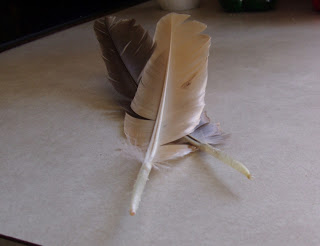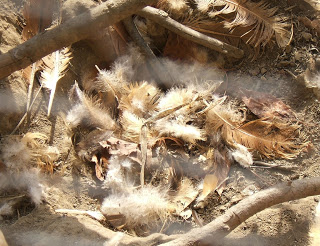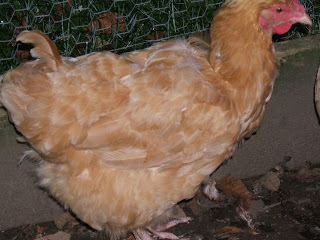
Fall is a time for falling leaves...and feathers. -
Molting is a natural process in which mature chickens lose their feathers and grow a new coat. My nesting boxes are full of feathers instead of eggs this week. Don’t panic. It’s normal. It’s healthy. But it sure ain’t pretty.
Egg production was in high gear just a couple of weeks ago. My happy little backyard brood of nine chickens was producing half a dozen or more eggs each day. Even the birds I hatched in the spring had jumped on the bandwagon, already becoming consistent layers. I had more eggs than we could use, to the delight of the friends and neighbors reaping the benefits. - But now we’re down to just a few eggs a day.
Although cheerful as ever, some of the girls have stopped laying and are starting to look pretty rough, as feathers fall like the autumn leaves.The molt is upon us.Over a period of four to eight weeks, these birds are going to drop all of their feathers. Some will lose them quickly, leaving them looking a little like that cartoon turkey that leaps up from the table and starts running around the room. Others may shed feathers gradually over a period of weeks, starting at the neck and underside and extending to the tail feathers and wings, leaving them looking patchy and maybe a little pathetic.
If you don’t know what you’re looking at, molting is a little unsettling and could easily be mistaken for an illness. And indeed, if it occurs out of season or over an extended period, it can be indicative of disease, problems in diet, or due to stress. But as the weather becomes cooler, molting is essential for the health of the backyard flock.
Molting is a natural process in which mature chickens lose their feathers and grow a new coat. Generally occurring in the fall as the days grow shorter, egg production stops during this time of plumage renewal.
Instead of laying, all of that energy is going toward getting those new feathers in place before the weather gets too chilly.
Whether a hard or soft molt (fast or slow loss of feathers), it is crucial that adequate protein be offered in the chicken’s diet. A lot of energy goes into growing new feathers, which are 85% protein. Although most commercial feeds fit the bill, some may choose to switch to a feed with a higher protein content during the molt.
Additionally, molting chickens will benefit from ranging opportunities. Grubs, worms and insects are all protein-rich chicken snacks.
This molting time serves not only to renew feathering, it is also a recovery period for a hen who is finishing up an eleven month cycle of egg laying. During this time, diet should be consistent, protection from the elements provided, and efforts should be made to limit external stresses. Let her put her feet up. Maybe watch a little TV.She deserves it. It’s hard being a chicken. -
See more at: http://www.hgtvgardens.com/chickens/backyard-chickens-what-to-expect-when-chickens-molt#sthash.Q5Ydiu1g.dpuf
Easing Your Flock Through a Molt
As a “seasoned” hen keeper, I can tell when it’s beginning. It’s partly the change in the temperatures from summer to fall and partly the evenings that arrive earlier and mornings that don’t brighten quite as early. Those are reminders.It’s the first hen that doesn’t join in the usual henny activities – when the other ladies are exclaiming over a late season grasshopper or other tasty treat, she’s still sitting in the dust bath or huddled in a sunny corner of the yard.
The first year or so, I was convinced the hen was sick. Her eyes
seemed clear, but her attitude was wrong: the usually flighty hens
seemed to snuggle right in when I picked them up to check them, and the
generally amiable girls would squawk and protest.
If you have chickens, you’ll know what’s coming next: egg
production slows down and the hen yard begins to look like someone had a
pillow fight.
 It’s molting time. This is the annual feather replacement that
occurs in chickens beyond their first year. Feathers serve as
protection, insulation and, according to Harvey Ussery in “The Small-ScalePoultry Flock”,
waterproofing and “sensory apparatus. Feather color and pattern can
either enhance the bird visually—as for mating displays—or help it blend
into its background to escape the notice of predators.” After a year
or so of daily wear, feathers become worn and must be replaced.
It’s molting time. This is the annual feather replacement that
occurs in chickens beyond their first year. Feathers serve as
protection, insulation and, according to Harvey Ussery in “The Small-ScalePoultry Flock”,
waterproofing and “sensory apparatus. Feather color and pattern can
either enhance the bird visually—as for mating displays—or help it blend
into its background to escape the notice of predators.” After a year
or so of daily wear, feathers become worn and must be replaced. Feathers are made of the protein keratin. They probably
evolved from scales, and in fact, you can see scales on your chickens’
legs and feet. There are several types of feathers on a bird – from the
insulating, fluffy down feathers next to the skin to the long flight
feathers on wings. If you look at a cast off feather closely, you may
see a tiny opening in the tip. That is where the blood entered the
feather as it was growing. After a feather is fully-grown, the tip
seals off from the blood supply. The tips of our nails and hair are
similar (and also made of keratin!).
Feathers are made of the protein keratin. They probably
evolved from scales, and in fact, you can see scales on your chickens’
legs and feet. There are several types of feathers on a bird – from the
insulating, fluffy down feathers next to the skin to the long flight
feathers on wings. If you look at a cast off feather closely, you may
see a tiny opening in the tip. That is where the blood entered the
feather as it was growing. After a feather is fully-grown, the tip
seals off from the blood supply. The tips of our nails and hair are
similar (and also made of keratin!).
Molting is NOT a sickness, but it makes your birds feel tired and
uncomfortable. The slow down in a hen’s egg production at this time is
not a coincidence. The chickens’ body is using most of its energy
growing new feathers. In a big way, this is a time of rest and renewal.
So. How can you, as a flock owner, help?
In large, commercial egg businesses, one of two things happens:
quicker molts are forced by withholding food and water and/or by light
manipulation or as soon as the hens slow down production they are
culled. In many backyard flocks, culling of the “old hens” happens at
this time, too. The new, spring chickens have begun to lay and the
previous year’s chickens go to the freezer for winter meals.
If, like me, you keep your hens over winter, though, there are a few things you can do to ease them through the molt.
· Adjust
the feed. This is probably the best, most important suggestion. Since
feathers are made of protein, your chickens will need protein based
feeds. Add some mealworms to their diet, if you can. Some people have
suggested that cat food and scrambled eggs make a good protein addition
to a molting bird’s diet. Try black oil sunflower seeds, too. If you are
feeding corn, cut that back if possible. The bird needs more protein,
not so much carbohydrate right now. Sprouted grains have vitamins that
can help your birds feel a bit better, too. You’ll find several recipes
for homemade cakes, muffins and cookies here at Community Chickens that
can help your birds through their molt.
· Reduce
stress. This feather growing time takes a lot of energy, and is a time
of rest for the egg laying “equipment”, too. I try not to introduce
new birds to my flock unless absolutely necessary, and I limit visitors
and handling, too. The coop is clean and ready for a new season, and
the fresh straw seems to invite long naps on autumn afternoons. Stress
in a flock can also lead to “picking”, and if growing feathers are
plucked or pulled, the area will bleed. Watch for this, of course, and
treat immediately.
· Add
supplements. Apple Cider Vinegar is something that can be added to
your chickens’ water (in plastic waterers). You can read more about
using Apple Cider Vinegar here in Jennifer Sartell’s popular post. Mineral and electrolyte additions are probably not necessary if you are supplementing with purchased feed.
· Make
sure a bathing area is available. Dust bathing helps remove loose
feathers when the molt starts, and may stimulate oil glands for preening
and smoothing new feathers as they arrive. I keep a bathing box filled
with sand and a sprinkle of diatomaceous earth in the coop for days
when the weather is not conducive to outdoor dust baths.
· Be
patient. Molting is a natural process, which can take from 3 weeks to 3
months (or longer). Here in Western New York, it usually begins to get
really cold right after the first of January, and always by that time, my chickens have been fully feathered and ready for winter chills.
You can tell when it’s coming to a close, too. Egg production will
pick up; you might find a “wind egg” or two in the nest boxes as
systems are re-charged and readied for another season. Your flock will
appear to be a bit more active and interested. If you listen to morning
clucks, as I do, they’ll have a more “gossipy” sound. Tail feathers
will be strong and sturdy; bodies will be sleek and smooth. Molt is
over for another year.
..

No comments:
Post a Comment